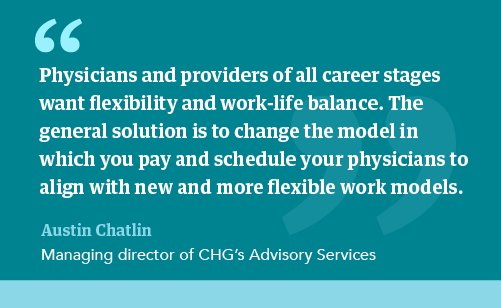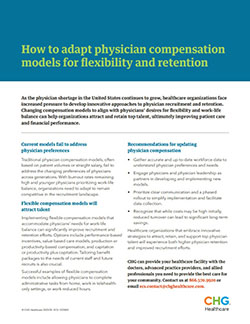
As the physician shortage in the United States continues to grow, the Association of American Medical Colleges (AAMC) has predicted a shortfall of up to 86,000 physicians by 2036. This alarming forecast places increased pressure on healthcare leaders to develop innovative approaches to their physician recruitment strategy.
“Physicians and providers of all career stages want flexibility and work-life balance,” says Austin Chatlin, managing director of CHG’s Advisory Services. “The general solution is to change the model in which you pay and schedule your physicians to align with new and more flexible work models.”

While that change will be challenging for many, organizations that step forward will see rewards. In fact, McKinsey cites redesigning compensation and incentive structures as a top strategy for retaining non-retiring physicians who are exiting their current role. Here’s how you can implement new compensation models to improve physician recruitment and retention.
Physician preferences continue to shift
As older generations retire and younger practitioners fill the ranks of practicing physicians, the factors that shape the provider experience are changing rapidly.
A recent study from Mayo Clinic found that over 45% of physicians reported at least one symptom of burnout. This is an improvement since the height of the COVID-19 pandemic, but a burnout rate of almost half of physicians represents a significant opportunity for progress.
While physicians of all ages are concerned about quality of life, new generations of physicians have higher expectations of work-life balance and job satisfaction. These Gen Z physicians—born between 1997 and 2010—expect flexibility in the management of their schedules.
Across the board, physicians want compensation that’s aligned with their family needs and well-being, incentivizing healthcare leaders to innovate flexible solutions that can balance both sides of the equation.
Become a preferred employer: How to recruit strategically in a competitive market
Flexible compensation models can improve physician recruitment
Physicians want more flexibility to support better work-life balance, but when compensation is weighted toward patient volumes—i.e., if half their pay is a bonus based on the number of patients seen—this misalignment creates conflict.
Some examples of flexibility include allowing physicians to complete administrative tasks from home, working in a telehealth-only setting, or even working as a 0.6 FTE.
This level of flexibility will require exploring payment structures beyond traditional straight salary or salary plus bonus models, including performance-based incentives and value-based care models. Other physician payment structures include production or productivity-based compensation and capitation or productivity plus capitation.
The benefit component of a compensation package also provides options to align with flexible scheduling options. Provider organizations should tailor benefit packages to the needs of both current staff and future recruits. Explore options in retirement plan offerings, insurance coverage cost sharing, wellness programs, and other employer-paid benefits. Work with your physicians to design benefit packages that meet their needs in balancing salary components and other benefits.
Accommodating this level of change could require adjustments to payer contracting. Include current physicians in efforts to redesign how they deliver care and services, and consider physician-focused alternative payment models that provide flexibility in care delivery, adequacy and predictability of payment, and accountability for costs and quality that your physicians can control.
Use physician feedback to create new compensation models
Successful implementation of financially viable, standardized, and flexible compensation models requires a deep understanding of your workforce needs and physician preferences. Accurate and up-to-date workforce data will be critical in creating a complete and actionable picture of your physicians’ wants, needs, and professional goals.
This exercise involves gathering data and opening channels of communication. Include your physicians and physician leadership as partners in developing and implementing new models and selecting the technology that will enable your goals.
Consider structured, two-way feedback mechanisms for communication, including focus groups, one-on-one meetings, and surveys. For additional levels of physician engagement, consider forums, task forces, and multidisciplinary committees.
Your physicians will need a thorough understanding of the complexity of their compensation packages and incentive structures. Avoid overly complex metrics or giving too much weight to measures that are outside a physician's control.
During implementation, prioritize a phased rollout to simplify communication and facilitate data collection and application. Be prepared for internal pushback, especially if your organization has been resistant to change in the past. Many organizations struggle in this area, believing some physicians are asking for too much.
“Some leaders have soured on physician demands, but not listening to physicians’ wants and needs can lead to significant turnover”, says Chatlin. “If you hire a recent resident and burn them out, and they don’t return after their contract is up, you’ve wasted a couple of hundred thousand dollars in costs that now you have to spend on recruitment.”

Planning, implementation, and compensation costs can be high, but the alternative in a time of provider shortages and increasingly challenging patient conditions is higher.
Address staffing challenges: How to create a flexible physician workforce
Modernized physician recruiting strategy pays off in the long term
While the cost of additional or more flexible compensation might seem high, reduced turnover can pay off quickly in the form of reduced costs. After all, recruiting just one physician can cost an organization anywhere from $180,000 to $250,000 in direct costs and recruitment incentives. This includes costs like search firm fees, marketing, interview expenses, and relocation stipends.
Being proactive about recruitment can differentiate your organization as a preferred choice for top talent in a time of intense competition. A successful physician compensation package that offers flexibility will be an asset in marketing your program to physicians of all career stages and specialties. Any investment made here can pay off quickly. Experts report that lowering physician turnover by just 1% can save up to $1 million.
Consistent staffing complemented by physician satisfaction can also improve patient care and financial performance. A 2019 concept analysis on physician engagement found it to be associated with multiple outcomes, including:
- Health system efficiency
- Patient satisfaction and experience
- Decreased errors
- Improved quality of patient care
- Improved adverse medical reporting
- Improved health outcomes
Some organizations, especially academic medical centers, might incorrectly believe they’re immune to the negative effects of physician turnover since they have extensive access to lower-cost residents and fellows. These organizations still suffer from lost patient-care revenue and loss of efficiency, productivity, and expertise at the departure of a more senior and experienced physician.
Compensation remains a critical component in physician recruiting strategies
The future of effective physician recruiting strategies will require a fresh way of approaching multiple facets of incentives. When leadership adjusts culture, scheduling, and compensation models to align with the desires and aspirations of modern physicians, organizations can reduce turnover, enhance the physician experience, and improve outcomes for their patients.
Healthcare leaders who embrace innovative strategies to attract, retain, and support top physician talent will discover rewards not only in the short term but most significantly in the ongoing future health of their staff and care communities.
Click the image below to download the Physician Recruitment Strategy one-sheet:

CHG can provide your healthcare facility with the doctors, advanced practice providers, and allied professionals you need to provide the best care for your community. Contact us at 866.570.9920 or email ecs.contact@chghealthcare.com.